Thursday, 11 February 1999
Punta Arenas, Magallanes, Chile
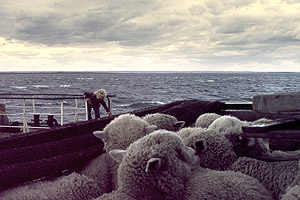
(Punta Arenas, Magallanes, Chile)
We only had the time (and money) for a couple of days in Ushuaia which was a shame because it looked like the weather was clearing up. We got up at dawn to get the bus back to Punta Arenas and again I was able to get some hopefully atmospheric photos of the land of fire. We then were confined to the bus most of the day. The most interesting sight was that of another Falklands war memorial (there was a big one in Ushuaia) which this time was less than subtle about declaring the Islands as Argentinean. When we finally got back we had a lot of difficulty finding any accommodation and so wasted half the evening in the futile search for something cheap to counterbalance our Argentina splurge.
Friday, 12 February 1999
Castro, Los Lagos, Chile
More buses and more crossing of the Chile-Argentina border. Our passports show that in the three days from the eleventh to the thirteenth we crossed the border once a day. The evening of the twelfth was spent zooming through the Atlantic coast of Southern Argentina which was equally as barren and sparsely populated as the North of Tierra del Fuego. We managed to pass the time with a curious mix of videos and the equally curious antics of some of our fellow passengers. The next morning we woke up to a treat, we were back in the Andes this time in the Nahuel Huapi National Park . In the middle of the Andes we had to again go through border formalities but it was not long before we were back on the road to Osorno and eventually Puerto Montt....
Saturday, 13 February 1999
Castro, Los Lagos, Chile
...We had rushed back in order to be present at the XIXth Pena Folklorica in Castro, the capital of the Island of Chiloé. We had done little apart from enjoying the great outdoors since we had got to Chile and felt it was time for something a bit more cultural. Fortunately the connections from Puerto Montt to the next door island are very good so we were straight off one bus and on to the next.. The bus drivers in Chiloé must be amongst the happiest in the world. They have only one road, very few stops, very little other traffic and lots of customers. We must have had the happiest bus driver and conductor in Chiloé, not only were they friendly to the passengers but they also waved to all passing buses, trucks, cars and policemen.
Castro itself was little different from Ancud. A little more lively perhaps but basically a collection of shingle houses and a port that looked as if it had seen better days. We had an amazing curranto in a restaurant around the corner from the hospedajie we found, delighted in the fact that we were able to eat something that was not steak for the first time in a long while. We then went to the gymnasium of the town hall to listen to folk music. Now there are two distinctive things about Chiloé its food and its music. The food is mainly a lardy bread, seafood and meat and lots of it. The music is mainly accordion, drum and guitar waltzes and again there is lots of it. Sadly the problem with both things is a lack of variety, all the dishes seem the same and so do all the songs. What we had seen in Ancud was repeated here in Castro, some groups were better some were very bad but most of them sang a song called "Hoy Curranto" and a couple of other numbers. We had a good time however and only wished that the Chilenos themselves had been more into it - not one person was dancing.
Sunday, 14 February 1999
Castro, Los Lagos, Chile
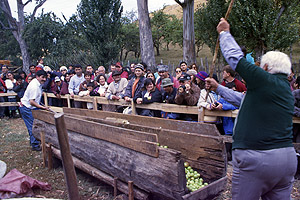
(Castro, Los Lagos, Chile)
Sunday in Castro seemed to be about as lively as Sunday in Punta Arenas. Whereas we in the decadent west have long since given into the joys of Sunday shopping the South Americans have yet to discover it. We wandered around, visited the randomly stocked museum and were really getting desperate when at about twelve we passed in front of Castros distinctive metal clad wooden church and encountered a group of guitar wielding hombres dressed in ponchos, spurs and sombreros. They played quite well and it turned out that they were advertising a mini-festival in one of the suburbs of Castro. We decided that with nothing else forthcoming we should follow the poncho wearing guitarists of Villa Llau-Llau.
By the end of the first half hour I was already getting tired of the format. I was developing a theory that these "festivals" which curiously coincided with the Chileno summer holidays were little more than a sophisticated way of selling a lot of empanadas and cervezas. This afternoon seemed merely to confirm this theory. The one event of interest was the Maja de Manzana where fresh apple juice was made by beating apples with sticks. Audience participation was the name of the game here and they hauled out a succession of couples to whack the apples in the process splattering the remainder of the audience with pulp. At the end they squeezed the remains in a press and filled hundreds of bottles with juice and sold them off for a terrific profit seeing as the punters had done all the work. This I guess was the sad thing, it was like country fairs in England or, I guess, anywhere else in the world. Little more than the result of a symbiotic relationship between stall holders eager for money and punters eager for something to do with their Sunday. I had hoped, before we left, that in some corner of the world they had retained their customs for reasons other than tourism. I was by now loosing all hope.
When we finally returned to Castro we sat in the room and twiddled our thumbs for a bit and finally decided that we could give the rest of the Pena Foklorica a miss. We would instead go back to our ramblin' ways and get back into the great outdoors. Not before we had another barrel of seafood though....
Monday, 15 February 1999
Castro, Los Lagos, Chile
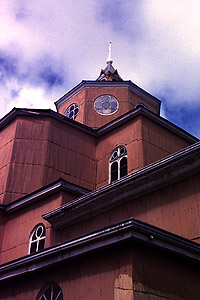
(Castro, Los Lagos, Chile)
The morning was spent on one last trawl of Castro which did dig up one gem. In the cultural centre they had a photographic exhibition of Chiloé's unique wooden churches. The photos were amazingly composed and very atmospheric and made you want to go straight out and spend a week looking around them. Sadly we were determined to get back out into the wilderness and as we passed quite a number of the churches on our bus ride to Quellon we had to be content with their exteriors. Quellon, the southernmost city of Chiloé, turned out to be even more full of character than the rest of the island. Although the town was not much to look at there was no mistaking that here the harbour was very much alive. Hundreds of yellow bottomed fishing boats were anchored in the bay and at the quay there was plenty of activity. We again returned to the welcoming arms of Navimag and with some trepidation booked ourselves on the Alenjandrina for the five hour trip to the remote town of Chaiten, back on the mainland.
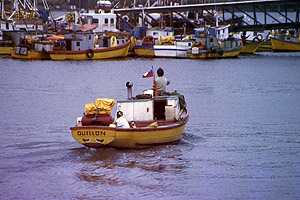
(Quellon, Los Lagos, Chile)
The trip was even duller than the hours wait on the quay side designed to ensure that the ship did not let Navimag down and leave on time. There was nothing to look at since everything was cloaked in mist, they did not have any slide shows and worse of all we missed half of "Deep Impact" and instead caught all of "Lethal Weapon 4" whose entire plot could be summed up in Gibson's poignant soliloquy - "Chinese mother f*rs". Navimag were again attempting to run the ship into the ground so had devised a near continuous schedule for it which meant that our boat got in at the incredibly useful time of eleven in the evening. We decided that we were going to pick our accommodation from what was offered by the touts on the dock. Naturally this time there were none and somewhat dejectedly started walking to town. We overtook a few people and pretty soon got to the front of the column. It was here that someone mumbled to us in a way that suggested to us he was selling drugs. We decided that he must be offering us a place to sleep so having few other options we followed him, as did half of the boat. We were taken to a barn at the back of someone's house and were shown a very cheap grotty room in a sort of half finished conversion. We went for it an were lucky we did, it turned out that the majority of the rest of the crowd ended up sleeping on the floor for not much less money.
Tuesday, 16 February 1999
Futaleufu, Los Lagos, Chile
It seemed there was some sort of conspiracy going on between the transport companies and the hospedajie and restaurant owners of Chaiten. The next bus to Futaleufú left at three thus we would have a morning doing nothing followed by a mad rush to sort out rafting and somewhere to stay that evening. We got out of the barn as fast as we could then wandered around a bit before having lunch. At lunch we were joined by a German woman who we had met first in Quellon and who seemed a bit lost. it turned out that she had wanted to go to the Laguna San Rafael but then had got worried about the fact that she had only two jumpers and rather than buying a cheap jacket had instead booked herself on a plane back to Puerto Montt. We sympathised slightly because when you see Chaiten for the first time wanting to get out as quickly as possible is a natural reaction. We swapped travel stories until it was time to go.
The drive to Futaleufú is pretty stunning. Especially the early stages where you skirt the edges of mountains shrouded in cloud and covered in ancient trees. Another impressive aspect was the size of the fuchsias, whereas they seem quite difficult to grow in England in Chile they grow like weeds and reach heights of over four metres. We caught our first glimpses of the Futaleufú about an hour away from the town. It has an amazing blue colour which reminded me of the Dullu river which we had traced on our trip from Guangxi to Guizhou province many months ago.
Futaleufú itself was a pretty basic place. Set amongst the mountains in a valley comprehensively cleared for farming yet only patchily farmed it consists of very little more than a few shops, some rafting companies and a very uncrowded Plaza de Armas. We had been recommended one rafting company by someone we met in Torres but when we eventually found it was closed. We then went to a more expensive looking place in a new hosteria, restaurant etc. complex and ran into a problem we did not expect. Of course you needed more than two people to go rafting, there were however no groups going in the next two days. We panicked a bit since we had gone to a lot of effort in order to get to the place and it seemed it was to no avail. We wandered the streets and eventually had the good fortune to run into another couple who had been on the same bus and were now faced with the same problem... so problem solved!!
Kim was an American studying for a year in Concepcion, Christian her Chileno boyfriend. We went to the rafting club they had found (and where they had haggled the price down) and arranged a trip for the next day. Kim and Christian were on a bit of a tight budget so were camping and since this is what we had also had decided to do we all went to the campsite. By the time we got there it was getting and dark. By the time a cheaper price had been negotiated, the three gringos hiding around the corner while Christian sorted it out, it was pitch black. We put our tent up pretty quickly and were organising everything inside when we heard a scream outside. It appeared that the other two had been talking to the owners of the campsite and whilst walking with them Kim had walked into the branch of a tree and now had it embedded in her eye. The owners rushed her to hospital and not knowing what to do we finished putting their tent up for them and shoved their stuff inside. It had seemed all our problems were solved an our beforehand now we were back to square one. We sulked for a while and just as we were getting ready to go to sleep the other two came back. It appeared that having had some wood removed from her eye that Kim was feeling a lot better, they also said that even if she did not go Christian would still come rafting, so back to problem solved!!!
Wednesday, 17 February 1999
Futaleufu, Los Lagos, Chile
For some reason that I will never understand the rafting was to start at three in the afternoon. Anyway we were forced to kill some time pottering around the campsite which in the light turned out to be set very nicely in woods at the side of the river Espolon. We then had a huge lunch and during this did some planning ahead. We wanted to get back as quickly as possible - to not loose another two days getting back from the place. We had found out that there was a bus to Puerto Montt via Argentina on Friday and since it was only Wednesday this left us with an extra day in Futaleufú which we did not mind. What I did mind was having to go over the border again and loosing more of my passport to exit and entry stamps for the two countries - but there was no other fast alternative. So after lunch we wandered around and rather than actually buying the bus tickets we looked for something to do on Thursday.
Whilst looking for rafting places we had found someone who did something called "canyoning". We decided to check it out and found the guide who very enthusiastically explained to us what it was all about. Apparently it involved walking to the top of the canyon of a small very steep river then descending it by any means possible, walking, sliding, jumping and most dramatically abseiling. I had abseiled before and quite like it and although not so enthusiastic about the heights mentioned (25m) Anna quite liked the sound of it. The trouble was the price we started off at seventy dollars each then lowered it to sixty but nevertheless it still looked a bit too much for our pockets. With much procrastination we said we would leave it for another day. Our decision held for all of about ten minutes and we went back to tell the guide we would do it, he had however gone to lunch and it was now time to go rafting. We left a message and went back to the Plaza de Armas.
All the kit was laid out on the street and despite it being time to get going no one had arrived. We hung around for a quarter of an hour and then Christian arrived almost at the same time as four other people, all Chilenos, who had put their names down after us. It turned out that there was a chance that Kim could come and was at the hospital getting her eye checked out again. Whilst waiting for her to come back and then sort out a pair of goggles to keep her eyes dry we got chatting to the others. Happily, for the conversation, it turned out that of the two couples both of the men spoke very good English. Jorge was a doctor in Santiago and married to Mary-Louisa a psychology student. Renaldo was a lawyer in La Serena and, by a complete coincidence, was also married to a psychology student, Andrea. Eventually, half an hour late, we were ready to load all the kit into the van and go.
We have only done white water rafting once before, in Bali, and although we liked it found it a bit tame. The Futaleufú is a world class destination for the sport and with several class V rapids is pretty hard going. Due to peoples' budgets etc. we had not opted for a trip on the hardest part of the river, we had gone for a more modest jaunt over a class IV and several III's. We had a blast, the river was very fast and some of the swells were over a metre and a half tall. The boat went all over the place and everyone repeatedly got soaked. In all they did four trips to allow everyone (the boat could only hold six) to have at least two trips. On our second trip they asked us if we would like to swim over a class II rapid. Foolishly Renaldo, Christian and I jumped in and did it. It was the closest I have ever come to drowning, you have waves continually crashing into you and although you adopt a special position this does not prevent you from smashing your arse off the tops of a few rocks. By the time we came out of it I was half drowned and more than pleased to get back into the boat. By the third trip Kim was a bit doubtful about her eye and Christian a bit tired out after his drowning. Andrea had also had enough so this meant that Anna, Renaldo and I could have a third trip along accompanying Jorge and Mary-Louisa who had not yet been. After the third trip it was getting a bit dark and cold so for the fourth and final trip it was only Jorge, M-L, Christian and I. We finished off pulling the raft out of the water practically in the dark and I was very, very tired.
We got back at eleven, not eight as had originally been proposed. We thought we had totally blown it on the canyoning front but we found someone who knew where the guide lived and he took me there. It turned out that Bruno, as was his name, had got our message and waited until ten thirty for us. He had also gone to the campsite but since Christian had done all the talking no one knew of any foreigners staying there. He looked rather wearied by our change of heart and all the waiting but when I said we were still on for it he cheered up a bit. We had a hurried dinner at a restaurant then returned to the campsite. Here we were to find a party in full swing. A fire had been lit and all of our fellow rafters, coincidentally we had all camped next to each other, were cooking sausages. We joined in with some wine that we had bought in anticipation and chatted more to the others. Both of thee Chileno couples turned out to be a lot of fun and we got on like a house on fire. We talked about everything: abortion (Chile is the only country in the world where it is not legal for rape); the law (there is no jury system); Pinochet (nobody really cared whether he would come back) etc. We finally turned in at three which was probably not the best thing to do when facing a day's canyoning but what can you do?
Thursday, 18 February 1999
Futaleufu, Los Lagos, Chile
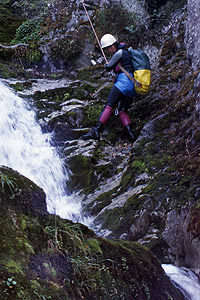
(Futaleufu, Los Lagos, Chile)
We met Bruno at quarter to nine the next morning to get kitted out. Canyoning involves a lot of equipment: ropes, harnesses, thick full body wetsuits, waterproof boxes, helmets and a plastic nappy. We found very tightly fitting wetsuits and loaded all the stuff up into a van and then set off for the hills. Once there we had an hour's walk up a dirt track to get to the start of the cayon-able part of the canyon. Whilst we walked we talked to Bruno about how he started canyoning in France (where he was from) and found out that he works primarily in Bolivia but this year had decided to come to Chile during the rainy season in Bolivia when it is too dangerous to canyon.
At the start of the canyon we got kitted up. My wetsuit proved to be almost impossible to get on but after a bit of coaxing I just about managed. Over this we put a climbing harness and then over this we put the aforementioned nappy which was a triangular piece of plastic sacking designed to protect the harness and the wetsuit whilst we were sliding down water chutes or rocks, which we did a lot of. After a brief bit of tuition we were underway jumping from rock to rock until we found our first water slide. This was in effect no more than a natural flume but whereas flumes are the same regular shape along their course when you are canyoning you get knocked from side to side and then dumped into a freezing cold pool.
Soon after the first slide we found our first waterfall. I had abseiled before but I still got a bit of a surprise. I got most of the way down the rock and then realised that there was no where else to go. I looked at Bruno and he seemed to be suggesting something inconceivable, I had to go into the waterfall. As I said I had little option so I stepped over into the waterfall and standing almost ninety degrees to the rock face I was pounded by the force of the crashing water. It was great fun and although it was hard to find places to put your feet behind the water I eventually got the knack of it. I think it was on the first waterfall, it may have been the second, but Bruno got us to let go a metre or so from the bottom and we fell backwards into the deep pool below. After the first waterfall we had to tackle some more of various sizes and then a huge water slide where you got so smashed around that I had to concede that the sliding element was not as pedestrian as it first seemed.
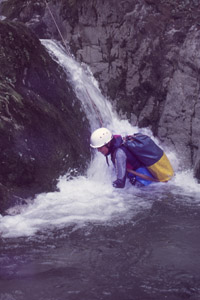
(Futaleufu, Los Lagos, Chile)
By lunch time two things had happened. Firstly we had begun to feel a part of the river. Not only were we abseiling in it, being submerged in it and sliding in it, we also spent most of the remaining time wading through it. Fortunately the wetsuits kept us from being the same temperature as it but we had travelled nearly every step of the way with it. The second thing was less exciting, my camera had broken. Some electronic fault caused by shock or a drop of water had meant that it was no longer focusing. I had been unable to get any shots of the most spectacular waterfalls including a great one where the water shot out over an overhang so that it fell in an arc into the pool below. We talked some more with Bruno over lunch and fortunately, having left it in the sun as a last ditch cure, my camera started working by the end of it.
The afternoon session was no less exciting. The great thing was that it was an amazing river. There were at least twelve sizeable waterfalls and we had to abseil all of them. Bruno also taught us the skill of jumping however I slipped a bit on my first jump and ended up in the wrong place almost hurting myself on the rock. We were also shown some of the other life in the canyon, birds' nests, tiny baby salmon etc. By the time we emerged from the pool of the final waterfall we were total converts to the sport of canyoning and were wondering when we would next get a chance.
Back in Futaleufú we had a drink with Bruno. We also had a major disappointment in that there were no tickets left for the bus to Puerto Montt. To somewhat soften the blow we bought a load of sausages and a couple of litres of wine and made our way back to the campsite. It was not long before the fire was roaring, the music was blaring and we were chatting away with the two Chileno couples (Kim and Christian had left in the morning). We had a great party that night as well, all got amazingly drunk, watched the stars, swapped addresses and talked a load of rubbish. We were really beginning to feel at home in Chile.
Friday, 19 February 1999
Chaiten, Los Lagos, Chile
In comparison to the previous two days' efforts it was a bit of a dull day with nothing but travelling and sleeping on the menu. Our depression deepened when we found out that all the plane flights were booked and we would be forced to spend another night in Chaiten and take the ferry in the morning. We found a much less grotty place to stay for not much more money and did virtually nothing all afternoon since it rained pretty much non-stop. The highlight was probably the huge slab of salmon I had for dinner.
Saturday, 20 February 1999
Puerto Montt, Los Lagos, Chile
We got up early to catch the ferry. Despite all our previous experiences with Navimag we still turned up, as they asked us to, an hour before departure. Although we still had to wait we did not mind that much as for once it was not raining in Chaiten and the skies were clear except for a few clouds of backlit mist which hung atmospherically around the mountains and the sharp peak of a nearby volcano. I had run out of film canyoning otherwise it would have made a good picture.
The ship left only a quarter of an hour late and before long there was not much of a view. We managed to eat up most of the time playing cards, watching films ("The Mask of Zorro" very funny) and writing diaries. Before we knew it we were stuck 500m out from Puerto Montt for no apparent reason. It was Saturday and we desperately wanted to start our next trek on Monday but the majority of shops would be closed on Sunday. We were pretty sure we could buy the food but I needed a film and I thought that the only chance of getting one would be if we hit town before eight. Sadly we were held up and it was quarter past eight before we got into town. Depressed I dragged my feet all the way to the same hospedajie (and room) where we had stayed many weeks ago and where they were pleased to see us. Fortunately on the way to dinner I had a brain wave and we popped into a very expensive and very western shopping mall which was still open and there we found a film shop which was still open. We went to bed safe in the knowledge that our foul up with the buses in Futaleufú would not cost us yet another day.
Sunday, 21 February 1999
Volcan Puyehue, Los Lagos, Chile
Rather than going into all the details of how we managed to avoid buying a stove by pre-cooking pasta etc. I will jump to the afternoon when we reached Osorno. We got out of the bus and as I picked up the luggage someone asked me "do you speak English?". Mark was an American who had come to South America with some friends to climb Aconagua, the highest peak in the Americas. His expedition had got snowed in for a week at the last base camp and only he had made it to the summit by joining another group ascending on another side. The rest of his friends had returned to the States but he was now travelling around on his own basically trekking and climbing. Perversely he had spotted our Nalgene flask (which was a Chinese fake) and correctly gambled that we had come to Osorno for trekking as well. It turned out that he also wanted to go to Parque Nacional Puyehue so we all clubbed together to solve the problem of how to get there (there are no buses there at the weekend). In the end Anna solved the problem, we took a bus to the closest town with buses, Entre Lagos, and then a taxi. There was some behind the scenes scam going on because a guy we had asked about transport arrangements in Osorno magically appeared in Entre Lagos to arrange our onwards taxi. Since it seemed that on Sundays Entre Lagos as a bit of a one taxi town we had no real choice other than hitching so we went for it.
We were dropped at the Guarderia of the National Park at Anticura. Anna and I had made a fatal mistake doing this because our food rations were based on the assumption that we would get stuck in Osorno and so have dinner there. Nevertheless we soldiered on and set up our tent, got a fire going and, with help from Mark's stove, managed to cook some soup. We stayed up a while chatting to Mark about his bad experiences climbing Aconagua - he had been the last to see someone who had made an attempt on the peak too late at night, one of a dozen or so people who had died just that summer alone. We also chatted about the rest of his travel plans and tried to put him off Eurorailing since he did not seem the sort of guy who would enjoy whizzing through ten capitals in twenty days with a train load of fellow Americans.
Monday, 22 February 1999
Volcan Puyehue, Los Lagos, Chile
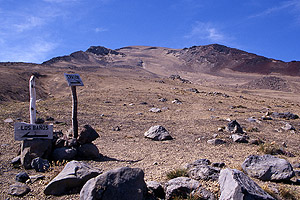
(Volcan Puyehue, Los Lagos, Chile)
We started separately from Mark who was planning a lie in. We did not start as early as we hoped because I had a problem with a film and had to employ my sleeping bag as a temporary dark room in order to extract it. Anyway shortly after ten we had deposited our excess baggage in the Guarderia and were walking up the road to the starting point of the trek. For some reason the only viable route up to Puyehue volcano was through the country retreat of one of Chile's Senators. Unfortunately the Senator had struck upon the idea of charging a fee to cross his land to get to the volcano and simply because he could get away with it had recently put the fee up to eight dollars a person. The National Park Guards had told us that this was because he was an ally of Pinochet and so was trying to raise money to pay for his lawyers. I found myself in the unique and slightly uncomfortable position of paying the costs of both holding and releasing him.
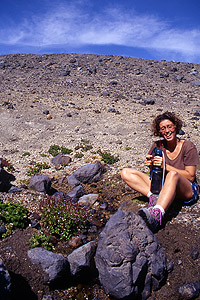
(Volcan Puyehue, Los Lagos, Chile)
The walk through the Senator's farm was pretty straightforward and well signposted. When we started hitting the slopes things got a lot harder. We had to ascend for nearly three hours through Quila (bamboo) and Lenga forests. It was pretty hot and the path was heavily eroded and required a bit of scrambling. we started to loose all hope of reaching the top when the path levelled out and we found ourselves at a refugio. According to our guide the next stage of the walk which would get us to Los Banos, a hot spring on the volcanic Puyehue plateau, would take another four hours. We were very tired and very low on water but decided to press on for fear of making a two day trek last for three days.
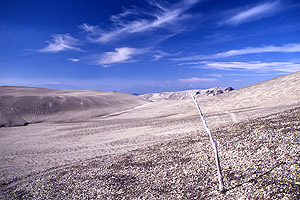
(Volcan Puyehue, Los Lagos, Chile)
The second stage of the walk was pretty easy going. We were basically circling the volcano and apart from a few ridges were pretty much contouring. About half a kilometre from the refugio the vegetation ran out and we found ourselves walking on eroded lava which was almost all we would see until we gain returned to the refugio. We managed to top our water supplies pretty soon after leaving the refugio from a trickle of a stream working its way down a totally barren gully just off the path. This was trickier than it sounded as it was badly signposted and in order to get to the water we had to traverse a few dunes of eroded pumice causing mini landslides with every step. After about an hour and a half of circling the volcano we found another spring right next to the path which nourished a tiny oasis in the totally barren lunar landscape of the volcano's slopes. We again topped up our water and headed on.
Around the corner from the spring the path popped up onto the Puyehue plateau, a vast plain which had been turned into a truly lunar wasteland by the volcano's 1960 eruption. It spread out below us, a sea of dunes, fumaroles and the odd field of black pumice boulders. It was clear that we would not be camping in the shelter of trees that night. Far in the distance we could see a minor, and presumably more recent, black lava flow from one of the volcano's side cones. It had flowed uninterrupted down several small valleys into a shallow basin on the far side of the plain. However it had run out of steam halfway across the floor of the basin and set solid. Looking at it from a distance it looked like a still of an eruption. The whole plain was a geography teacher's dream, it was identical to one of those labelled diagrams used to teach pupils about vulcanism.
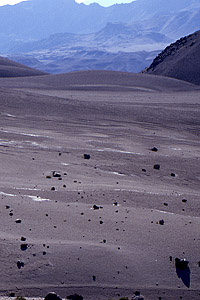
(Volcan Puyehue, Los Lagos, Chile)
We marched on absolutely amazed by the landscape unfolding around us. One minute we would be walking through a small valley with puffing fumaroles blowing sulphurous clouds at us, the next we would be crossing fields of red and yellow stained pumice. All the time we kept glancing out over the unending white grey dunes to try and spot the next marker stick or a feint trail. It was very hot and we really felt like intrepid explorer's crossing the Sahara. Our illusions about being lost in the desert were shattered by the discovery of water. Two springs, both of which were marked on our map, emerged from nothing and their streams had cut deep channels into the lava. These channels were vibrant oasis of green and with one of the streams being totally orange from iron (I think) they made very striking pictures.
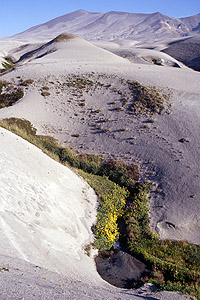
(Volcan Puyehue, Los Lagos, Chile)
Again we were reaching the point of giving up when we climbed the top of the last dune and found ourselves looking into the small basin containing Los Banos. There were already four or five tents there so we knew that our eight hour walk was over. We quickly put the tent up, struggling since the pegs would not go in more than an inch, and made for the Banos. The hot springs (Los Banos) were certainly hot but were suffering from a lack of maintenance cause in part by the fact that the handle of the "digging-out" spade had been considered as the only source of firewood at some point in the past. We stripped off and laid in them, suffering because our heads were too hot our feet too cold (the hot spring mixed with a cold stream) and lying face down our arses stuck out of the water and got whipped by the wind. Lying face up I felt even more exposed (!) so decided to try and dig myself a hole using the remains of the shovel. This proved quite successful but the deeper you dug the hotter it got and the larger stones got so hot that it was like having cigarette stubbed out on your back. It was also getting dark so after about half an hour we decide d to call it a day and have some dinner.
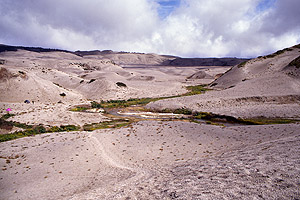
(Volcan Puyehue, Los Lagos, Chile)
It is now time to go into some of the culinary details I glossed over in a previous entry. Rather than buying a stove for thirty dollars we had decided to buy two Tupperware boxes. This was mainly down to the fact that the only stoves available were gas and if I was going to splash out on a stove I would want a multi-fuel one. Sadly MSR do not have a sales outlet in Puerto Montt so rather than wasting a load of money on something we would not keep we decided to brave some cold dinners. We had bought some fresh pasta in Puerto Montt and cooked it up in the hospedajie and packed it away into the Tupperware boxes. On the whole it was a pretty top idea (not really workable for longer treks though) and it saved us a lot of money. However that night, in the middle of a volcanic desert, having come from a half cold hot spring with the wind howling through we felt like a old meal was the last thing we needed. Fortunately help was at hand in the form of an even hotter spring. One of the springs was so hot that by shoving our pot of pasta sauce in it we were able to warm it up a little and so have a luke warm dinner.
That night we got our first real taster of desert weather. As soon as the sun disappeared it was desperately cold and we had to retreat to our tent and confine ourselves to cards and some pisco sours (our one little luxury was half a bottle of pisco). We got a surprise however. At some point in the night it started raining reminding us that we were not actually in the desert. The rain continued to lash against the tent all night which kept me especially awake for most of it.
Tuesday, 23 February 1999
Volcan Puyehue, Los Lagos, Chile
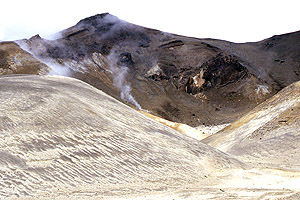
(Volcan Puyehue, Los Lagos, Chile)
We woke up to the sound of the rain still lashing against the tent. We had planned to make an early start on the four hour return trip to some bubbling mud pools but one look at the clouds of mist outside told us that at best it would be a late start. We made an executive decision to stay in bed.
When we finally ventured out the rain had cleared up a bit but the clouds of mist had not. We chatted to some Germans who were just packing up to go and they said they were not doing the side trip - they had met someone who had and they said that the pools had dried up a lot since the trekking guide had been written. We pontificated a bit and in the end decide to go back splitting the trip over two days to possibly allow us to climb to the rim of the volcano. We slowly packed up the tent, considered braving the hot spring one more time and then thought better of the idea. Our trip back was not quite as spectacular, mainly because up in the clouds visibility was particularly poor. One thing I kept kicking myself about was that I had not taken any shots of the four or five other volcanoes (Osorno, Casablanca etc.) because it was hazy on the first day and the photos would have been pretty watery. Now all we could make out, if we squinted really hard, was the base of Osorno. The rare times we were not cocooned in cloud it was so no photos. In fact I never got a photo of Osorno which, as you would know if you have ever seen it, is a bit of a shame because it is a perfect snow-capped cone shape and is often likened to the Japanese's beloved Mount Fuji.
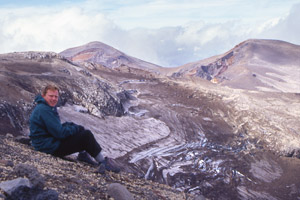
(Volcan Puyehue, Los Lagos, Chile)
We considered walking the two kilometres or so to the perfect lava flow we had seen the day before but opted against it in favour of an ascent of the volcano. One of the major attractions of the ascent is the view of the surrounding peaks you get from the top. Of course we would not get this but we were bloody minded enough to just do it to say we had reached the top. We hid our packs behind a rock and started to climb. For our tired legs it was very slow going. After half an hour we came to a gully cut by a glacial stream. We noticed a problem, whilst the path led across the gully the next marker stick was further up on our side of the stream. We foolishly decided to follow the marker stick and it took us another half hour of scrambling up a steep slope desperately looking for cairns before we got back on the easy route up. The side of the volcano as well as being covered with tiny pebbles of pumice was also carved up by the activities of glaciers. There were several small moraines that we threaded our way through and at the top the summer remnants of a dirt covered glacier slowly melted into a tiny stream. The final approach had us zigzagging our way up very steep eroded slopes until we popped up onto the wide rim of the crater. Predictably the crater was not the perfect circle the map would have you believe, one side had completely disappeared. But it was impressive enough, with sulphur stained rocks and a glacier with crevasses in it which allowed you to see successive years of snow deposits as you would rings in a tree. I assume that every summer the snow would melt leaving behind the grit suspended within it (or fallen on to it) as a thin brown layer.
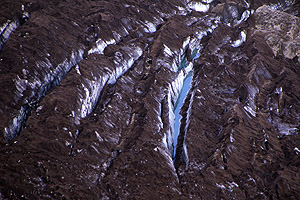
(Volcan Puyehue, Los Lagos, Chile)
We got down in a third of the time it took to get up. The fine sand which had resulted from the erosion of the path was much easier to "ski" down than trudge up. When we got to the bottom it was only a short walk to the refugio where quite a number of people had already set up tent. Pretty soon we had set ours up under the cover of a small stand of trees. We then had our cold pasta. This time it did not seem quite so bad as the sun was making a late appearance and warming us up slightly.
Wednesday, 24 February 1999
Temuco, Araucania, Chile
We woke up quite early and packed away the tent quickly. We had no idea how we would get back to Osorno but knew that whatever the method it would take a long time. Again the erosion meant that it was a lot easier to get downhill than it had been to get up and pretty soon we were strolling out of the gates of the Senator's retreat. Back at the guarderia we retrieved our spare bags and changed into more respectable clothes to enhance our chances of hitching a lift. The next bus was not until six the next morning. Hitching was hard. The road we were on connected Osorno with the Argentine border and was the main route for Chilenos to get down to the south of their country. As a result most of the traffic was composed of families stuffed into mice looking cars. It took about an hour of eating dust until the first truck turned up and slammed on its air brakes.
Owing to our recent experience with the park guard's Pinochet jokes we decided to say that I was Canadian. The truck driver who had picked us up in fact turned out to be Argentinean so maybe it was a worthwhile precaution, maybe he would not have cared but we needed the lift to badly to risk that he did not have a relative that died in the Falklands Conflict. However he certainly did have relatives who lived in Canada and had big dreams of visiting the place. He asked us so many questions, "Where do you live?", "Do you have big animals in Canada?" that we began to see that there was a whole lot more work involved in adopting a fake nationality than thrillers would suggest. We decided against doing it again, although the chances were that we would not have to.
Our driver turned out to be quite a long distance merchant continuously plying the roads between the two countries and Brazil. He was single and liked holidaying on the beaches of Chile because it was cheaper and the "Mujers" more "hermosa". It was interesting being in the cab of a truck for the first time, especially a fast one because you got to see just how much other drivers got scared. It was like being in an ambulance, cars would invariably pull onto the hard shoulder in order to let you overtake. Fortunately our driver's destination was Osorno and after he had delivered his load he was more than happy to drop us at the bus station in his cab.
The bus to Temuco took far too long because of road works. One point of interest however was the choice of film: Dante's Peak. Considering our recent volcanic experiences it was both reassuring and frightening. It appeared that, contrary to my suspicions, you could actually drive over a lava flow without your engine overheating, the whole thing melting or the petrol tank exploding. The minor problem of your tires catching alight apparently disappears by the next scene. The big danger however is that the lakes turn into sulphuric acid so tend to melt your future mother-in-laws legs, but maybe if she had listened to your warnings in the first place...
Temuco turned out to be a pretty ordinary sort of place and we soon found somewhere to stay and eventually (as everything listed in our guide had long since closed) found a restaurant. We went to bed with the sole intent of sleeping as long and as deeply as possible.
Thursday, 25 February 1999
Temuco, Araucania, Chile
Not really much happened in Temuco and we really should not have bothered spending even one day here let alone our planned two. The city is effectively the capital of the region inhabited by the Indian Mapuche people whose music Anna was interested in. We soon found that there was very little way in which we could see it live outside of a festival and so had to make do with a CD. Mapuche artifacts were however available in the market, a seamless blend of seafood restaurants and stalls selling musical instruments. It was hopelessly touristic with every stall selling the same junk at very marked up prices. We kept wanting to buy something but either its quality or price would put us off.
We orbited the central shopping area several times and finally gave up finding any of the things we needed (I needed new sandals) or any vestiges of Mapuche culture (apart from several very proud and very menacing looking women one of whom fiercely spat on the ground on approach). We nearly went to bed early but we stumbled on an English book in the Hospedajie and not having seen one for several weeks we read it from cover to cover that night. It was an appalling crime thriller where the author spent a lot of time trying to convince you one of the main characters was guilty and then introduced a spotty emergency telephone operator with (no kidding) "Maple syrup urinary disease" in practically the last ten pages.
Friday, 26 February 1999
Temuco, Araucania, Chile
We had intended to wake up early and go to a Mapuche village but our book reading efforts and the fact that Anna had an upset stomach when we finally got out of bed put paid to this. We followed up our final lead, a cooperative of Mapuche women who had a shop in town (which had moved otherwise we would have found it on the first day) where they sold crafts, the proceeds being ploughed back into the community. We turned up and found ourselves in a shop that would not have looked out of place in Islington. What little there was of a high quality, there were no artisans "available to discuss their work", the shop assistant looked less like a Mapuche than I do and a PC quietly hummed in the corner. Trying to cage my cynicism I looked around for something nice and when we eventually found something this was the result:
Anna: Excuse me, what is this?
Assistant: Its a camera or guitar strap.
Anna: Huh?
Assistant: ...Erm...no its actually a band that the Mapuche wrap around their heads during religious ceremonies.
It was at this time we gave up. Maybe we had to get out of Temuco to find the Mapuche but with all this bullshit going on I would expect the Mapuche would not want to be found. After all imagine turning up at a High Anglican church with a cassock wrapped around your head bandana style.
By this point Anna really was not feeling well so we went back to the hospedajie and read for a while, moved to a cafe for more reading and then had dinner. Our bus was scheduled to leave at quarter to eleven but by some amazing act of ineptness they had managed to double book our seats but gave us some guff about another bus breaking down. They wanted to shift us on to the bus of a less expensive company which was due to leave half an hour later. During all the stress and ensuing shouting some piece of shit managed to open Anna's bag and steal my sunglasses from it. This was the second time this had happened in Chile, the second time my sunglasses had been lost and the fifth pair of glasses overall that had walked. Since we had not manage to loose any other single item I was starting to get the feeling that Anna was cursed.
Despite the late hour departure we were still treated to a movie "An American President" featuring Michael Douglas supported by Michael J. Fox. It was as if the script had been written by the Whitehouse PR department the major motif being that as long as the President runs the country correctly who cares what he does with his social life. After all its tough on the big guy who can not even order flowers or any of that other romantic stuff without his aides being involved. It was the sort of film that even if you were sympathetic to the general concern at the beginning you were screaming "impeach" by the end of it even though Douglas was a widower and guilty of nothing more than a pretty drippy relationship with Anette Benning...
Saturday, 27 February 1999
Santiago, Chile
We were more than happy to be back in Santiago. However by lunch time I started to realise that it was not only Anna who was suffering from a minor dose of food poisoning. After getting some films developed we were forced to retreat to the hotel to try and sleep things off. I picked up an International Herald Tribune and, apart from a tragic avalanche in Austria, was delighted to see the world was pretty much as we left it. Everyone still worried about Saddam and the Balkans splitting into smaller and smaller pieces like the never ending unwinding of a fractal. We weakly ventured out for dinner before our final collapse.
Sunday, 28 February 1999
Santiago, Chile
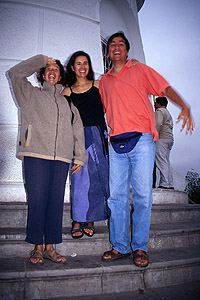
(Santiago, Chile)
We both felt a lot better but the final day of February was sadly a Sunday. We tried to pretend that it would be business as usual but after failing to find an Internet cafe we realised that it was not to be. We decided to give our friends Jorge and Mary-Louisa a call on the off chance that they too had made it back from Futaleufú. Fortunately they had and they came and picked us up and took us to their flat in Providencia for breakfast. The minimalist furnishings of their flat reminded us very much of our first few months in ours. Like us they had moved into the flat owning nothing and like us they had been incredibly picky about what they bought for it. Like us they had ordered a sofa after a lot of searching around and had to put up with weeks of waiting before it was finally delivered. They however had sent it back after delivery because they did not like it the result being that after six months they still had no more than a few cushions on the floor, which is what we had to endure for the first month or so. They were not permitted to redecorate but had they been I am sure that in a few weeks time they would have entered into the never ending limbo of always having one more room to paint that we had only just escaped from the month before we left.
After breakfast we whipped around to one of their friends' houses to peak at our e-mail and then came back for lunch. Jorge and Mary-Louisa were just amazing, they looked after us like kings and despite our concerns that we were somewhat hogging the last Sunday of their holiday would not let us go. We chatted throughout the day about Chile and the rest of the world. After lunch they took us to the Doctor's Club which Jorge was a member of and which had a massive outdoor swimming pool. The unfortunate thing was that by the time we got into the pool the weather had turned from cloudy to very cloudy and cold. However even the cold was not enough to empty the pool and just as I had done a couple of lengths and was thinking of getting out the dancing started. Yes, you heard right, the number one most annoying dance tune in South America was put on at full blast, three female members of staff started demonstrating the moves and everyone in the pool began moving in time standing waist deep in the shallower area of what was a pretty shallow pool. The interesting thing is by now we had realised that in South America all songs had a bit of a dance that went with them, kind of like the one for "YMCA" or that all-time favourite "Agadoo", and that a great importance is attached to knowing the dance. Anna danced along but I choose to get a few more lengths in and take a few compromising pictures.
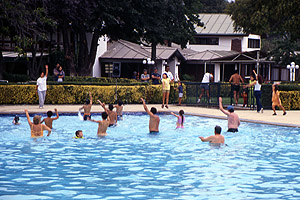
(Santiago, Chile)
We finally gave in to the cold, got dressed, had a cup of tea then left. Jorge then drove us to the top of Cerro San Cristobal, one of several large hills overlooking Santiago. At the top was a pretty amazing open air church and a pretty big statue of Christ. From the steps of the statue you could look out over Santiago and start to realise how large it actually is. I often wonder what London would look like if viewed from a central hill (which of course it lacks). I suppose it would look no bigger than Santiago as there is a limit to how far you can see especially when the pollution gets in the way. One of these days I guess I ought to go to the top of Canary wharf and find out. After this we checked in at a wine shop run by someone that used to work in an Oddbins in London. He seemed to have picked up on certain aspects giving wine a bit of a trendy image etc. but had totally missed on others. There were no handy labels describing the nicest bottles and the assistant on duty seemed reluctant to give a recommendation. In the end we found a cabernet sauvignon with a jazzy label which was fairly good. We drank it with some cheese and salami back at their flat, a cultured end to one of the most relaxing days we had in a long while.
Monday, 1 March 1999
Santiago, Chile
Anna needed to spend a day in the National Library doing follow up research on the Mapuche Indians. I sat with her in the morning and then spent the afternoon looking for some replacement sandals - mine were disintegrating rapidly. I do not know why it was so difficult, I think the problem was that it was sale time and the shops only had left over stock. Whatever it was it was a pain, I would find a pair of sandals that I liked only to find that they did not have it any sensible sizes. The thing that amazed me was a lack of apathy amongst the staff. In London shoe shop staff jump on you, in Santiago you have to jump on them. As an example of this when I finally did get some sandals the next day I had to serve myself and when we went to pay I had to shout at the assistant "Mas Rapido" because he had decided out of the blue to help a customer in the middle of writing my bill.
We went to the second hand English book shop for the second time, gave the woman back the books we had taken the first time and were pleased to note that she had no luck in shifting the two books we had sold her last time. We picked some more books which was hard because there seemed to be very little on top of what there was last time. We steered well clear of Arthur Haley... we were getting very close to reading everything he had ever written. After this we went to see a movie, revelling in the fact that for once we could choose. We went for "There's Something about Mary" a film i had wanted to see for a while and that I knew would be a laugh.
Tuesday, 2 March 1999
Santiago, Chile
Pretty much a bus day. We had opted to try out "Salon de Cama" class for the long trip up to Calama. Basically you pay more money and you get a lot more room. The seats are like business class and there are only twenty four passengers. However the rest of it was not up to much, the video was wrecked and the choice of film dire. I tried to watch the first one but when it came to "Air Force One" dubbed into Spanish I gave up. The catering situation was just as bad, if you did not like chocolate you were in trouble as the only thing you would have been able to eat was a single sandwich. Worse than this they did not stop anywhere long enough for us to grab anything more than a nuked hot dog.
Wednesday, 3 March 1999
San Pedro de Atacama, Chile
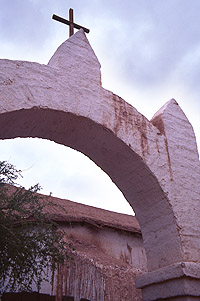
(San Pedro de Atacama, Chile)
The view from the bus window gets more desolate as you get closer to Calama. Before Antofagasta you at least have the sea an a few cacti to look at. Afterwards the road swings in land and you enter the Atacama desert, supposedly one of the most perfect deserts in the world for its lack of rainfall. For the second time on the trip we found our idealistic image of a desert being challenged, it was more like a quarry than a sand pit. Calama itself was pretty forgettable. We had two and a half hours wait before the bus to San Pedro de Atacama was due to leave so we found a restaurant and, still suffering from a Lomo overdose went for a pizza.
As the bus to San Pedro got closer the desert started to get more attractive. Red weathered rock outcrops spilled shards on to the floor of a small valley that we passed through. The whole landscape started to take on a Martian feel. San Pedro itself nestled in the centre of an oasis fed by a few tiny streams on their way to the Salar de Atacama. It lived up to its image the residents living in enclosed courtyard adobe houses. The streets were narrow and dusty, it was hot and it was very, very quiet. We found a very nice residencial which had very basic but clean rooms arranged around a courtyard. In the courtyard there were several tables with huge canvas shades which made it a perfect place to hang out, read and write.
San Pedro's image as the original desert pueblo began to ware a bit thin as soon as we hit the main street. As expected every second shop was a tourist agency and the others were pretty pricey restaurants. We found a very cool looking courtyard restaurant which was blasting out Portishead and went in. The prices were phenomenal by Chilean standards but the food was quite good.
Thursday, 4 March 1999
San Pedro de Atacama, Chile
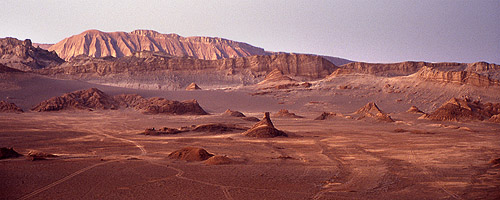
(San Pedro de Atacama, Chile)
We had already decided that we would relax that morning and this is exactly what we did, sleeping until quite late and then doing little more until lunch. After lunch we walked around a bit and found the church, built of white washed adobe it really looked the part, and the leafy central plaza. You sort of got the feeling that San Pedro was doing well on tourism and had polished up its rough edges with buildings getting re plastered regularly etc. However the trees in the square were old as was the church, so here at least you felt you got a glimpse of San Pedro as it always has been.
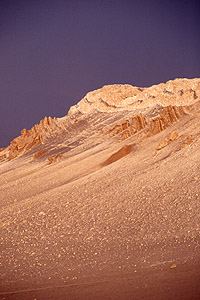
(San Pedro de Atacama, Chile)
It is always good to avoid what tours you can and so we were happy to learn that you could cycle to a few of San Pedro's attractions most importantly the Valley of the Moon. We hired some chunky looking mountain bikes and set off. It soon became clear why the bikes had such excellent suspension, the road was badly surfaced and heavily rutted. We were being shaken apart within minutes of leaving town and I had to try hard to find the path of least resistance. We cycled through pretty barren and unattractive terrain at the base of some low hills for about three quarters of an hour before reaching the salt caves. This gave me plenty of time to find out that the gears on my bike were not really working the front derailer failing to move the chain off the middle gear except a couple of times when the chain came completely off.
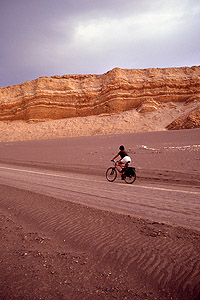
(San Pedro de Atacama, Chile)
The salt caves were not that amusing, one of the problems with doing things yourself is that you do not have a guide. Not that this normally makes a difference since in all of the tours we subsequently took not a word was said to us. However we bumped into a group going into the caves and their guide was waxing very lyrical. As far as I could see the surrounding hills were either completely made of salt or had huge seams of crystallised salt running through them. We saw massive chunks of it on the way in, the clear crystals for the most part were obscured by a brown dusty covering. After a while of walking through a narrow gorge we found ourselves in a narrow cave, presumably the result of a stream washing out the salt. We walked up this for a while then turned back not knowing if there was anything of interest further into the caves or how safe they were.
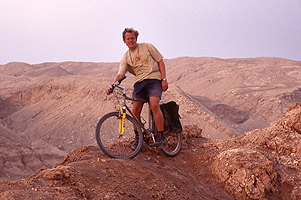
(San Pedro de Atacama, Chile)
The remainder of the journey to the Valley of the Moon was uphill and we actually walked most of it. Being quite honest we were not yet acclimatised to San Pedro's two thousand metre altitude and with the gears on my bike playing up I could not cope with the long uphill. I think it was during this stretch that we felt a couple of drops of rain on us and this, and the overcast conditions, made us think twice about the "it never rains in the Atacama" thing. The valley itself was barren but not that spectacular we dumped our bikes then scrambled up a huge black sand dune to look at the view. It was a bit cloudy for good photographs but as time went on the sun started to poke out. We walked along the spiny ridge of another hill and had a look around on the other side of the dune before deciding to go back. As we dropped down the dune thousands of tour buses descended on the valley in order to watch the sunset from the big dune. We were glad we did not stay as the colours were not that spectacular and we were able to make more of what little there was on the road back. We returned to San Pedro around nine and found a slightly cheaper and less trendy place for dinner.
Friday, 5 March 1999
San Pedro de Atacama, Chile
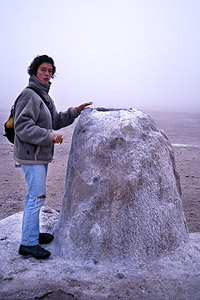
(El Tatio, Chile)
For some reason the guide books say that the best time to visit El Tatio , the world's highest geyser field, is dawn. Following this all the tour companies run buses there at four in the morning. We have often been rewarded by outstanding sunrises and so were quite excited to be getting up at this time. Half asleep we stumbled into a waiting minibus. The fact that there were two of us caused some confusion and it appeared that the company had overbooked. The result was that someone who we suspected was the guide had to get out and could not come with us. We then fell into a half sleep as the minibus struck out into the night along some pretty terrible roads. When we finally arrived it was something like half past six, it was still dark and it was very cold. In order to keep warm we stood in the sulphurous steam of one vent until the driver of the bus finally decided to lead us through the geysers.
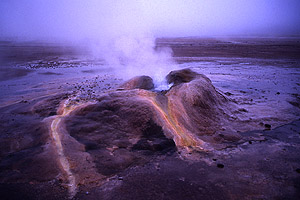
(El Tatio, Chile)
As the light gradually built up we realised that the whole area was wreathed in clouds. Nevertheless we walked around the various bubbling and steaming vents, slowly as we were at over four thousand metres. It was a pretty impressive display of nature in action. After a while we came upon what I would traditionally think of as a geyser, a column of water shooting a metre and a half into the air. It was not exactly "Old Faithful" but it was still quite a sight. Probably the most impressive thing were a few pod shaped formations of mineral deposits. The water bubbling out of them deposits layer upon layer of minerals building the structure up from a small dome to a metre and a half high pod. I tried to take a picture of one of these steam spewing pods but the light was not really enough. We shuffled around a bit more until we returned to the bus for a cheese sandwich and tea breakfast.
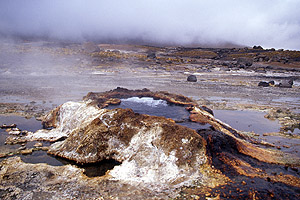
(El Tatio, Chile)
The second half of the program was to be a hot bath. We drove to the other side of the geyser field where we found a muddy pool. Two die hards had already climbed into it but putting my hand in I realised that it was little over twenty degrees so the likelihood was that we would end up even colder. Instead we spent what seemed like hours walking around the area which contained some very hot pools, more bubbling vents and a quite impressive churning whitewater pool. The vegetation consisted of a strange tufted yellow grass which grew in scattered tufts all over the area. By the time we had to go the sun was making an appearance and I wished we were going back to the "pods" but sadly we set off in another direction.
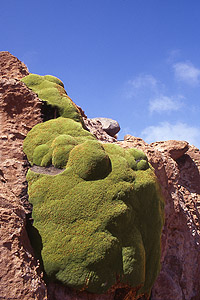
(San Pedro de Atacama, Chile)
The way back was probably the best thing about the trip. We travelled through some amazing altiplano countryside nestled between several giant volcanoes. We stopped for a while to see an amazing gorge where, growing on the square red cliffs, we saw our first llareta - a bright green affair which sort of looks like a moss but when you touch it is actually as hard as stone. We also travelled through a valley densely covered in tall cacti. They were the branched ones that I associate with cartoons of the wild west but here I was seeing them in real life.
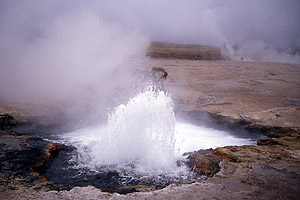
(El Tatio, Chile)
After the excitement of cacti San Pedro seemed a bit quiet. We were meant to go to the museum that afternoon but we could not quite drum up the enthusiasm. Instead we stayed in our shady courtyard and again nothinged away the afternoon and the evening.
Saturday, 6 March 1999
San Pedro de Atacama, Chile
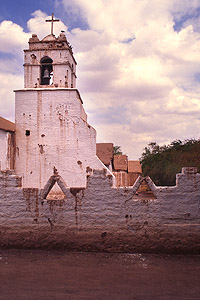
(San Pedro de Atacama, Chile)
We made a bit of a mistake with our next step. We had always planned to go from Chile to Bolivia on the train from Calama to Uyuni. However we had found out that a tour agency ran a three day jeep safari through the southwest of Bolivia which would get us to Uyuni in three days. It would take in some of the amazing countryside such as the Salar de Uyuni and the Flamingo populated lakes which we would otherwise have to see on a circular trip from Uyuni. When we went to the office to book departing on the sixth however there were over twenty people going. We were worried that it would be more like a train journey than a safari so we delayed our departure until the seventh on which there were no passengers. Naturally when we came to pay on the sixth another twenty passengers had turned up and we realised that we would have company whenever we went.
Thus we lost another day in San Pedro, not so bad because it is one of those places where relaxation comes very easily. The only thing we did was to finally go to the museum. This was interesting in a frustrating way since it was very well laid out but everything was in Spanish. Anna asked if there were any translations but was told we would need a guide. She thought they meant guide as in a person so we passed on it. In actual fact we found out at the very end that there was a printed book. We managed okay without it however and had a nice time strolling around the mummies, pots and stone tools. Of special interest was their huge collection of decorated tablets and pipes that the Tiwanaku and later the Incas used for snorting hallucinogenic drugs. They would not have looked out of place in modern drug culture and it was interesting to see the roots of a practice which hundreds of years later would result in stock brokers snorting up cocaine in nightclubs through rolled up tenners.
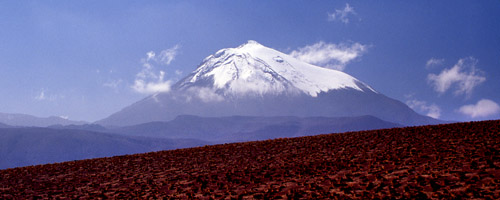
(San Pedro de Atacama, Chile)
We were a bit short on actual cash that night wanting to save some for the South of Bolivia where cashpoints are few and far between. After a bit of searching we found a restaurant that displayed a Visa sign. We went in and asked if they took it which resulted in a lot of amusement. We found out why after our meal. It was the first day they had the machine, they did not really know how to use it and the phone lines were constantly engaged. It took about ten minutes until they got it sorted out...




